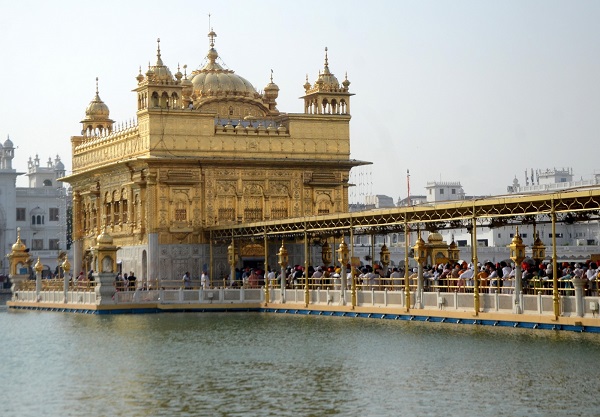(Asian independent) Forget culinary travesties like ‘Gobi Manchurian’, overlook the blaring ‘peppy’ bhangra numbers — and the big fat weddings they are played at — or the present-day ‘gangsta-rap’ flooding the state, don’t consider the stereotypical depictions of the people as alcohol-guzzling, butter chicken-feeding and flamboyant hedonists. This is certainly not what “Punjabiyat” is.
Like all human constructs, “Punjabiyat” can be a subjective topic, but there are certain forms of cultural, religious, and literary expressions that can have a preponderance of rights to the label.
The teachings of the Sikh Gurus and the other pirs from the Land of Five Rivers, the soothing refrains of ‘shabads’, say “Koi Bole Ram Ram” or “Taati Wao Na Laagaye”, the humour, subtle or in-your-face, of Khushwant Singh (literary), Hazara Singh Ramta (songs), or Jaspal Bhatti (audio-visual), the ‘tappas’ of Jagjit Singh could certainly qualify.
Then, a plate of delectable “sarson ka saag”, paired with “makki ki roti”, with a dollop of (preferably home-made) white butter, with a glass of thick white lassi, the famed ‘Amritsari’ dal-wadi, phirni, and so on are better examples than the Sino-Ludhianvi cuisine that has overrun and ruined our palates — “Chilly Paneer”, anyone?
Some more instances could include, in the ever-popular sport of cricket, the gutsy tenacity of Mohinder Amarnath, who, with the minimal protection available in those days, withstood the ferocity of some of the most lethal bowlers ever — Malcolm Marshall, Michael Holding, Richard Hadlee, Jeff Thomson, et al — or the guile of Bishan Singh Bedi, and the sense of relief that came when Kapil Dev strode in determinedly with the bat, or took the ball.
Then there is the acting prowess of the Kapoor clan, led by the redoubtable Prithviraj, who is possibly the only one in cinema to play both Alexander and his Indian rival, Porus, the remarkable range of Rafi, folk songs about “humane outlaws” (Jagat Singh Virk alias Jagga Jatt or Jagga Daku), and the like.
And that is, if we ignore the sundered part of Punjab, separated by the Radcliffe Line, where there is a parallel cultural development — but that may be outside the scope of this piece.
Let us look at some more examples, from the Indian context, across various spheres.
Bollywood has long been a happy playground of talented Punjabi, from the heroes (Dev Anand, Balraj Sahni, Sunil Dutt, Dharmendra, Jeetenda, Rajesh Khanna, Vinod Khanna, and more), heroines (Vimmi, Rati Agnihotri, Anita Raj, Juhi Chawla, Raveena Tandon, Priyanka Chopra, among others) and villains (Pran, Prem Chopra, Ranjeet, Amrish Puri, Gulshan Grover), and Hindi films have frequently showcased Punjabi settings and characters.
Beyond the Yash Chopra films with their obligatory Punjabi wedding songs or lovers reaching out to each other in mustard fields, there have been films that have showcased Punjabiyat much better.
One prime example is the National Award-winning “Nanak Naam Jahaz Hai” (1969), starring Prithviraj Kapoor, I.S. Johar, Nishi and Vimi, about human relationships and the resilience of faith, and as per the award citation, based on a true incident that took place at the Golden Temple.
And then, where there have been various depictions of Punjabis, especially sardars, in films, and their songs, the best one, though representing a rather jaundiced look at human affairs, but unmatched for its sheer exuberance is “Main Koi Jhoot Boliya…” from Raj Kapoor’s experimental “Jagte Raho” (1956).
As our hero, mistaken for a thief after entering a city apartment in search of water, is chased and we get a view of various sordid activities of more “genteel” folk, he stumbles into a virtual ‘dera’ of Punjabi and Sikh taxi drivers, unwinding with this searing bhangra song.
Scored by Sail Chowdhury (a Bengali, for the record), it is, however, Prem Dhawan’s lyrics — “Haq duje da maar-maar ke bande log ameer/Main ainu kahnda chori, duniya kehndi taqdeer” — that make it a cultural marker.
Also key is the appearance of Manohar Deepak, known for his zesty bhangra moves onstage and onscreen — “Naya Daur” (1957) is another leading film where he is seen dancing with abandon.
And from there, there is the boundless realm of music.
Gurdas Maan, and then Daler Mehndi, may have brought Punjabi songs into the national mainstream, but the musical tradition has always been vibrant.
Pakistani singer Musarrat Nazir, with her “Vyah De Geet”, was a staple of all Punjabi weddings with traditional songs like “Mathe Te Chamkan Wal”, “Mehndi Ta Sajdi De” and “Sada Chiryan Da”, but then, Indian Punjab could as well boast of accomplished singers such as Asa Singh Mastana (“Kali Teri Gut”), the Kaur sisters Parkash and Surinder — known for their renditions like “Lathe di chadar”, “Suhe ve cheere waleya” and “Kaala doria” — which still resonate, in some form, across time and space.
There is much more to Punjabiyat — in art, literature, and else — but these could be some prime examples.








